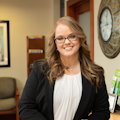How referring patients to a specialist can be mutually beneficial
As a single-doctor, general care practice, we believe in providing the best possible comprehensive, restorative, and preventive care to guide our patients toward their overall health goals. Dentists are expected to recognize the treatment needs of their patients and when referral may be necessary. In order for our office to focus on the details of preventive care and highly clinical restorative procedures, we rely heavily on local specialty practices to step in for patients’ non-routine dental needs.
Referring to a consulting dentist allows patients to receive care from a professional with specialized training to meet their unique needs. Specialists have invested not only in their own extended education, but also in the tools and equipment needed to assist them in treating patients more efficiently. Consulting dentists rely on referring dentists who trust them enough to send their patients for care. Professional relationships like this, built on mutual trust, could be very beneficial for your practice.
The consulting specialty offices we partner with have truly become an extension of our team. Our ability to refer patients to them is essential in providing patients with the best care and treatment outcomes possible. As the referring practice, it is our responsibility to manage the overall care of our patient. This includes initiating and overseeing the referral process from start to finish. There are a few key steps we have implemented to simplify the process for our patients and build strong relationships with our consulting specialty offices.
Communicate the details
All parties need to understand what is necessary to complete the referral process. Once the evaluation has been completed, the general dentist should report the findings to the patient and discuss all of the treatment options and alternative therapies available. Allow the patient to become involved in their own treatment decisions. Once it has been decided that a referral is necessary, the general practice should assist in the patient's introduction to the specialist. Being on the same page with the specialty office is the best way to make sure that the patient’s needs will be met. Most specialty offices have their own referral slip; however, this only introduces the patient and doesn’t always tell the entire story. A detailed treatment letter from the referring dentist is the best way to clearly explain patient history, diagnosis, oral health goals, and conversations with the patient including any of their concerns. This also allows the referring dentist to inform the consulting dentist of the intentions and needs of returning the patient back to the general practice for continued care.
Set expectations
At this point in the process, the general practice team has put a lot of work into building trust with the patient. To hear that they have to go to a different office and see a different dentist could cause a bit of stress. It is important for your team to instill the same level of trust in the consulting dentist; after all, they are an extension of your team. Be sure to thoroughly explain what the patient can expect during the referral process. Offer them some comfort and insight regarding the team and doctor that they will be seeing. Be sure that they have clear directions on how to get to the new office. This is also the perfect time to explain what will be needed after their visit with the specialist. Discuss treatment thoroughly; will they need to return to your office, and if so, how long after the specialist visit? If it is unknown what the follow-up process will be, assure them that you will be contacting them to discuss next steps once they’ve met with the consulting dentist.
Follow up
Once the general practice has helped the patient schedule an appointment with the specialist and the patient has been sent with the information, touch base with the specialty practice to be sure that they have everything they need to see your patient. Send images, a letter from the doctor, insurance information, and inform them of any special needs or concerns the patient has. This will prepare the specialty practice to take over care. If the patient was not ready to schedule, be sure to follow up with them to offer help in scheduling if needed. After the patient is seen, the consulting dentist is responsible for sending communication back to the referring dentist to thoroughly explain the findings and if any treatment was completed. When this written communication gets back to the general practice, it’s time to contact the patient to discuss next steps. Being sure that the patient had a good experience is also key; you want to make sure that they don’t have any remaining concerns after their visit with the specialist. If there is no need for a follow-up visit with the general practice and treatment is complete, then offer assurance that your team is available for them should anything be needed and that you will see them at their next clinical hygiene visit.
Following these recommendations for clear communication, setting expectations, and following up will not only result in the best care possible, but will also help solidify a positive working relationship with consulting specialty practices. This relationship will, in turn, benefit your practice and possibly result in see referrals coming to your office when a specialty dentist needs a general practice for their patient—turning simple referrals into a truly beneficial and professional partnership for your practice.
About the Author

Tiffany Dalton, MAADOM
Tiffany Dalton, MAADOM, is the practice administrator for Murdock Family Dentistry in Billings, Montana. She is a member of the American Association of Dental Office Management (AADOM), and serves as the president of the Yellowstone Valley AADOM Chapter. Tiffany was inducted as an AADOM Master (MAADOM) in September 2021. She has a passion for helping people find tools for personal and professional growth, and hopes to be an inspiration to others. When she is not in the office, Tiffany enjoys event planning, singing, and spending time with her family.
Updated September 17, 2021

